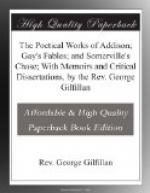Altogether now worth above L3000, having been admitted by the Duke of Queensberry into his house, who generously undertook the care alike of the helpless being’s purse and person, and still in the prime of life, Gay might have looked forward, humanly speaking, to long years of comfort, social happiness, and increased fame. Dis aliter visum est. He had been delicate for some time, and on the 4th December 1732, at the age of 44, and in the course of a three days’ attack of inflammation of the bowels, this irresolute but amiable and gifted person breathed his last, and was buried in Westminster Abbey. The last work he was occupied on was a second volume of “Fables,” which was published after his death. He had become very popular, not merely for his powers, but for his presumed political principles, a “little Sacheverel,” as Arbuthnot, his faithful friend and kind physician, calls him, and yet his modesty and simplicity of character remained entire, and he died while planning schemes of self-reformation, economy, and steady literary work. It is curious that Swift, when the letter arrived with the news of Gay’s death, was so impressed with a presentiment of some coming evil, that he allowed it to lie five days unopened on his table. And when the Duke and Duchess of Queensberry erected a monument to his memory, Pope supplied an epitaph, familiar to most readers of poetry, and which is creditable to both. Two widow sisters survived Gay, amongst whom the profits of a posthumous opera, entitled “Achilles,” as well as the small fortune which he left, were divided.
Gay’s works lie in narrow compass, and hardly require minute criticism. His “Beggars’ Opera” has the charm of daring singularity of plan, of great liveliness of song, and has some touches of light hurrying sarcasm, worthy of any pen. Burke used to deny its merit, but he was probably trying it b too lofty and ideal a standard. Hazlitt, on the other hand, has praised it overmuch, and perhaps “monstered” some of its “nothings.” That it has power is proved by its effects on literature. It did not, we believe, create many robbers, but it created a large robber school in the drama and the novel; for instance, Schiller’s “Robbers,” Ainsworth’s “Rookwood,” and “Jack Shepherd,” and Bulwer’s “Paul Clifford,” and “Eugene Aram,” not to speak of the innumerable French tales and plays of a similar kind. The intention of these generally is not, perhaps, after all, to make an apology, far less an apotheosis of crime, but to teach us how there is a “soul of goodness” in all things. And has not Shakspeare long taught and been commended for teaching a similar lesson, although we cannot say of Gay and his brethren that they have “bettered the instruction?” Of “Trivia,” we have spoken incidentally before; of “Rural Sports,” and the “Shepherd’s Week,” it is unnecessary to say more than that the first is juvenile, and the second odd, graphic, and amusing. None of them is equal to the “Fables,”




